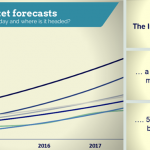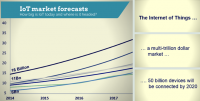RW Q&A: Singapore’s CIO weighs in on IoT and smart cities
RW Q&A: Singapore’s CIO weighs in on IoT and smart cities

Singapore, the booming Asian city-state, is one of the world’s leading smart cities. With technology-driven-government projects stretching back decades, it remains at the forefront global smart city innovation.
To further its ambitious Smart Nation 2025 plan, Singapore recently launched two new agencies focusing on innovation-related aspects of this complex smart city strategy, one of which is the GovTech agency.
Chan Cheow Hoe is the new deputy chief executive of GovTech and, more sweepingly, is also Singapore’s Chief Information Officer.

Chan Cheow Hoe, Singapore’s CIO and Deputy Chief Executive of GovTech
Chan spent more than 20 years in the financial services sector, running technology at such banks as Barclays and Citibank. However, two years ago he signed on with as the Singapore government’s CIO, bringing with him a wealth of private sector knowledge.
He sat down with ReadWrite to outline the approach he brings to Singapore’s Smart Nation strategy and to the new GovTech agency, which is a unique mix of governance, technology strategy and multi-agency implementation. His comments have been edited for length and clarity.
ReadWrite: As Singapore rolls out its Smart Nation 2025 plan, what are some of smart city revelations you’ve had?
Chan: In the past, we tried to build ourselves out of problems. But now many cities are realizing they can’t build any more roads, because there’s not enough space. There’s a limit to the number of train lines or hospital beds you can build. This is where the new technology comes into play. Smart Nation is about using technology and data effectively to optimize the use of the scarce resources and infrastructure that you have.
See also: White House plans to help with smart city projects
RW: Can you give me an example of one of Singapore’s successful smart city initiatives?
Chan: If you look at smart transportation, the question is how you make public transportation more efficient. So we took all the bus transportation data, and we used concentration analysis to develop the BeeLine Singapore app. We started mining the data and got these dynamic routes planned out, then brought it to the bus companies who needed to become comfortable with these routes. And then people could go online and suggest other routes we could begin drilling into, because it’s also about engaging the community to help you solve these problems. And it also uses Open API so entrepreneurs can develop apps.
RW: Speaking of Open API, how can governments foster innovation using open data?
Chan: Everyone talks about open data but it’s not free. Good quality, dynamic data costs money. Ultimately if data is so useful, and generates economic value and it costs the government a lot of money to provide, it creates big questions plaguing many countries. At what point do you start charging for data? And what kind of data should be charging for? Perhaps using a freemium model, where you consume free for seven days and beyond that it’s going to charge you. But those models aren’t available yet, and many countries are currently assessing it.
RW: What are some obstacles that governments face when rolling out smart city programs?
Chan: The biggest challenge most nations face about smart cities, and I’m going to be a bit controversial here, is everybody is doing POCs (Proof of Concept), but nobody is able to scale up. There are POCs everywhere. You go to one street there are 20 smart lampposts and 20 smart bins and it stops there. So what happened to the rest? Twenty smart dust bins isn’t going to improve the lives of citizens. So its more important to ask how do we make use of the data and the infrastructure to create impactful applications that improve the lives of citizens and businesses.
RW: So how can programs like Smart Nation improve the lives of citizens, particularly the poor or vulnerable?
Chan: We have to be realistic about things that this initiative isn’t going to solve all the problems in Singapore, it’s not going to cure cancer. So we are very selective about how we can use technology to solve certain problems. Like with Singapore’s rapidly aging population, how do you provide the right level of tertiary care using technology? An important part is about data again, how you transmit data from one point to the other. But one of the big realizations is that it’s just not about technology, it’s about acceptance. How do you get care personnel to convince old people that it’s ok to be wired up for two hours a day? There’s a lot of change management there. A lot of smart city initiatives focus on technology for the sake of technology but it has to be humanized.
RW: As CIO to an increasingly wired country, how do you handle the ever-evolving security threat to Singapore’s vital systems?
Chan: This is a game you can never win, because you’re always playing catch-up somewhere. It is a prioritization exercise, because it takes a lot of money to protect everything. That’s when you determine which are the critical and non-critical systems and you offer different levels of protection. Some systems go down for two days and life goes on, other systems go down for 2 hours and life is very painful. We isolate some systems, building resiliency into some systems becomes important. But it cannot be one-size-fits-all because it costs you too much money and there will never be enough resources to handle that.
RW: As Singapore is becoming increasingly connected, how are you addressing threats from the Internet of Things?
Chan: It’s serious problem, because a lot of IoT devices have zero protection, it’s a simple pass-through. There is a mystification around Internet of Things but security for IoT is actually very simple. Is the data classified or is it non-classified? If it’s non-classified the data can go anywhere. It depends on what data you’re carrying and what level of data it is in terms of privacy and security. The question of when the data becomes sensitive is really where the challenge is. At some point when you process data it could become sensitive, either from a privacy point of view or a security point of view. The processing, that’s where the security comes in. But you can’t protect every single end point, because that is impossible.
See also: Blockchain drives Wanxiang’s $ 30B smart city project
RW: As the country’s CIO how have you managed to tackle the perennial government challenge of getting multiple departments and agencies to collaborate effectively?
Chan: For a lot of these whole-government projects that touch multiple agencies, normally we do it centrally, with the funding through the Ministry of Finance. Because if you expect every agency to fund it themselves, these projects will take five years to do. But how do we get agencies to conform, when they are always protective of their systems and their data? For many of these multi-agency problems we’ve given up on trying to integrate systems. So we changed the architectural approach so that instead of integrating systems, we integrate with data.
RW: How did this data integration approach work for example with Singapore’s OneService app, which handles citizen-reported problems for 14 different government agencies?
Chan: We built a centralized software that does the routing, we built a front end and then we plugged everything through using API calls. We didn’t touch any of their systems, because integrating 14 agency’s systems would be impossible. This is instead integrating systems with data. We built a system of engagement, and we left the system of records, with the legacy systems just becoming a database. This is a concept I brought from the banks. We built this is just 9 months and people were shocked because in the past this would have taken five years.
RW: What practical smart city advice would you give to other governments?
Chan: Our architectural concept really helps us because it takes away the splitting of hairs between “my system and your system”. That is why we are moving very aggressively towards an API economy. All I care about is if an API is there I can build an app. That’s why we have a government API gateway where we funnel all these APIs through. That allows us to build front-end, user-centric apps. As needs change, they are more agile this way. And over time these systems become quite easy to replace, because there are very few processing rules in there any more, so the migration process becomes easier too. Otherwise, if you keep building on these legacy systems one day it will just be a Frankenstein.
The post RW Q&A: Singapore’s CIO weighs in on IoT and smart cities appeared first on ReadWrite.
(48)














